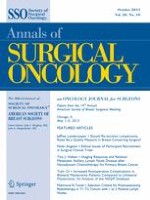Erschienen in:

01.10.2013 | Breast Oncology
The Value of 6-Month Interval Imaging after Benign Radiologic–Pathologic Concordant Minimally Invasive Breast Biopsy
verfasst von:
Demitra T. Manjoros, MD, Abigail E. Collett, BA, Jose J. Alberty-Oller, MD, Thomas G. Frazier, MD, Andrea V. Barrio, MD
Erschienen in:
Annals of Surgical Oncology
|
Ausgabe 10/2013
Einloggen, um Zugang zu erhalten
Abstract
Background
Current National Comprehensive Cancer Network guidelines recommend repeat imaging 6–12 months after a benign radiologic–pathologic concordant image-guided breast biopsy. We hypothesized that interval imaging <12 months after benign concordant biopsy has a low cancer yield and increases health care costs.
Methods
An institutional review board-approved retrospective chart review identified 689 patients who underwent image-guided breast biopsy at Bryn Mawr Hospital between January and December 2010. Charts were evaluated for documentation of radiologic–pathologic concordance.
Results
Of 689 patients, 188 (27 %) had malignant pathology, 3 (0.4 %) had nonbreast pathology, and 498 (72.3 %) had benign pathology. Of 498 patients with benign findings, 44 (8.8 %) underwent surgical excision as a result of discordance, atypia, papillary lesion, or other benign finding. Of the remaining 454 patients who did not undergo excision, 337 (74.2 %) had documented radiologic–pathologic concordance. Interval imaging <12 months after benign biopsy was obtained in 182 (54.0 %) concordant patients. Five (2.7 %) patients had suspicious [American College of Radiology Breast Imaging-Reporting and Data System (BI-RADS) 4] findings on follow-up imaging. Only one breast cancer was identified, representing 0.5 % (95 % confidence interval 0–3.4) of all benign concordant patients undergoing interval imaging. The cost of detecting a missed cancer with interval imaging after benign concordant biopsy was $41,813.77 in this cohort.
Conclusions
Interval imaging performed <12 months after benign concordant breast biopsy demonstrated a low yield for the detection of breast cancer and resulted in increased health care costs. Our data support the policy for discontinuation of routine interval imaging after benign concordant biopsy.